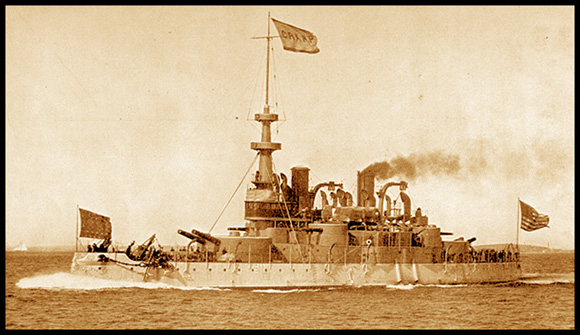


On March 27,1898, USS MASSACHUSETTS was ordered to Hampton Roads, Virginia to join Commodore Schley's "Flying Squadron" which was being formed to protect the ports of the American east coast from the threat of Admiral Cervera's Spanish fleet. On May 13, she departed Norfolk for Cienfuegos, Cuba, where she took up blockade duties on the 22nd. Later that month she went to Santiago with the rest of Schley's force. On the afternoon of May 31st, along with USS IOWA and USS NEW ORLEANS, she bombarded the forts at the entrance to Santiago harbor and exchanged fire with Spanish cruiser CRISTOBAL COLON, forcing the enemy ship to retire to the inner harbor.
MASSACHUSETTS remained on patrol off Santiago, intermittently bombarding Spanish fortifications, until July 3, when she departed to coal at Guantanamo Bay, missing the Battle of Santiago. She returned on the 4th, arriving in time to help USS TEXAS force the Spanish cruiser REINA MERCEDES to beach and surrender at midnight on July 6th. Following duty in support of the American occupation of Puerto Rico, from July 21st to August 1st, MASSACHUSETTS steamed for home, arriving at New York August 20th.
After the Spanish-American War, MASSACHUSETTS was used for training duties from 1904-1906 and decommissioned in January, 1906. She was refitted in 1909, and recommissioned in May, 1910 as training ship, being again decommissioned in May, 1914. MASSACHUSETTS was recommissioned as a gun training ship in June, 1917, and became a target ship late in World War I. She was decommissioned for the final time on March 31, 1919, stricken in November, 1920. Turned over to the War Department, MASSACHUSETTS was scuttled off Pensacola for use as artillery target in January, 1921. Her hulk returned to US Naval control in 1925 and was offered for sale as scrap. Oddly, there seems to have been no takers, even during World War II. The wreck became property of the State of Florida in 1956 and is now a state underwater archeological monument.
The armor thickness and size of the main battery exceeded any that on any other ship in the US fleet, including the newer classes of battleships.
One disadvantage of MASSACHUSETTS and her sisters was a relatively low freeboard, which made the guns difficult to operate in heavy seas.
The main gun mountings were not centralized, so when the guns were aimed to the side, the ship would submerge farther on the side of the vessel to which the guns were aimed. This limited the elevation the guns could attain. Also, this resulted in the main armor belt being lower one side than designed and higher on the other when the guns were being aimed in this manner. The situation was eventaully rectified by adding counter-balances to the rear of the turrets. The mountings themselves continued to be a source of mechanical difficulty.
The ship rolled excessively until retrofitted with bilge keels.
As was typical for ships of this time period, coal bunkers were placed along the exterior hull of the ship to act as additional armor protecting the magazines. The proximity of the coal bunkers to the magazines created a danger that could result in the loss of the vessel. Spontaneous combustion of coal dust was not unusual, and a coal bunker fire could ignite an adjacent magazine.
| Classification: | Sea-Going Coast-Line Battleship, BB-2 | |
|---|---|---|
| Keel Laid: | June 25, 1891 | |
| Launched: | June 10, 1893 | |
| Comissioned: | June 10, 1896 | |
| Rig: | One military mast. | |
| Armament: | Four 13" barbette guns | |
| Eight 8" barbette guns | ||
| Four 6" guns | ||
| Twenty 6 pounders | ||
| Six 1 pounders | ||
| Two Colt Gatling Guns | ||
| One 3" field piece (for landing parties) | ||
| Three Whitehead torpedo tubes | ||
| Contractor: | William Cramp & Sons, Philadelphia, PA. | |
| Length: | 348 feet | |
| Beam: | 69 feet 3 inches | |
| Mean draft: | 24 feet | |
| Max. draft fully loaded: | 27 feet, 1-3/4 inches | |
| Displacement: | 10,288 tons | |
| Complement: | 32 officers and 441 enlisted men. | |
| Engine type: | Vertical triple expansion engines with a 42 inch stroke, | |
| generating 11,111 hp. Twin screw. | ||
| Boiler type: | Four double-ended and two single ended cylindrical boilers. | |
| Speed: | 16.2 knots | |
| Coal bunker capacity: | 1,594 tons | |
| Endurance @ 10 knots: | 5,500 nautical miles | |
| Armor: | 18 inches on sides, 6 -17 inches on turrets |
Gardiner, Robert, Ed., Conway's History of the Ship: Steam, Steel & Shellfire - The Steam Warship 1815-1905, (London: Conway Maritime Press Ltd., 1992).
Naval History Department, Navy Department, Dictionary of American Naval Fighting Ships, (Washington DC: Government Printing Office, 1959).
Reynolds, Francis J. The United States Navy, (New York: P. F. Collier & Son, 1918).